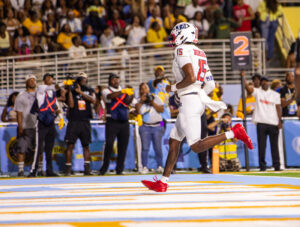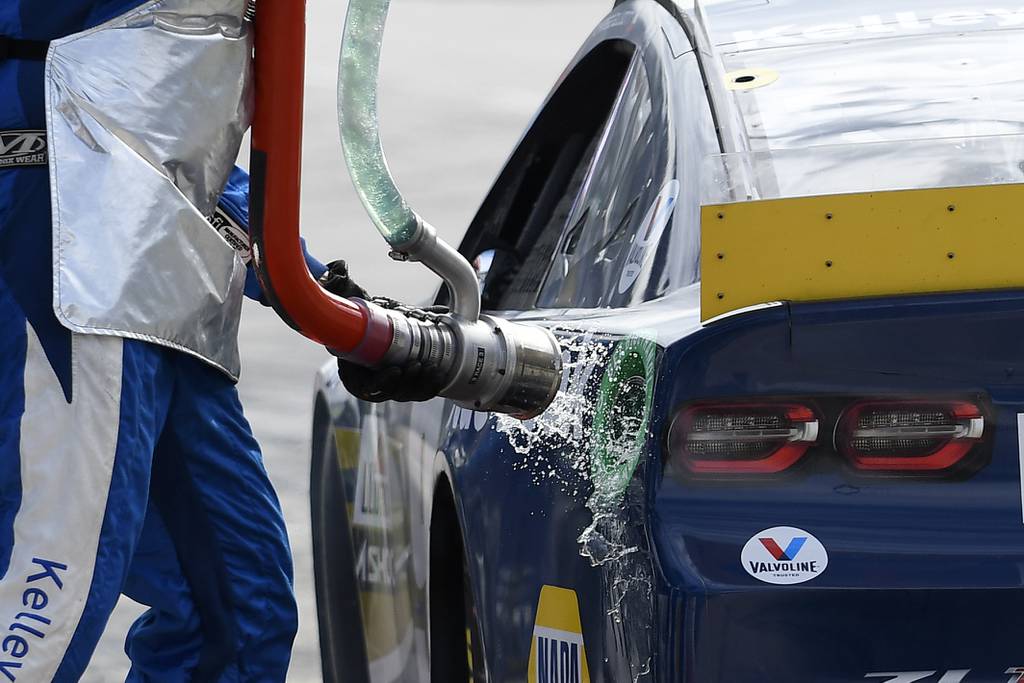Growling engines and squealing brakes are an integral part of the allure of auto racing.
In less than a week, Chicago will host its first NASCAR street race where elite stock cars that average around 5 mpg in a typical race will be hitting speeds over 100 mph downtown.
As race cars turn and brake, as tires screech, fine particulate matter is released into the air. And unlike commuter vehicles, race cars aren’t required to have pollution control devices that filter exhaust gases.
Among the 25 most polluted cities in the country, Chicago has plenty of its own air quality problems. In addition to factory and local vehicle emissions, pollutants from Canadian wildfires have regularly obscured the skyline over the past month. On July Fourth, the city will let loose with fireworks that can introduce, on a national average, 42% more pollutants into the air than are found on a normal day.
But many residents are also worried about the NASCAR race, complaining about pollution concerns, as well as traffic, safety and noise.
Evanston resident and retired mechanical engineer Fred Wittenberg said he is apprehensive about how race cars will contribute to air pollution in the city, especially if temperatures are hot and the air is stagnant — conditions that the city has been experiencing over the past month and ones that contribute to ozone and particle pollution.
“It can be very, very warm and humid, typical for July,” Wittenberg said. “And I can only imagine what’s going to happen with crowds down there and these cars racing around on Saturday and Sunday. That is my concern.”
Experts, researchers and engineers, however, say the environmental consequences of a two-day NASCAR race are more nuanced.
“On one hand, it’s like a drop in the bucket, right?” said Greg Shaver, a mechanical engineering professor at Purdue University, referring to how emissions from vehicles that normally would be on downtown roads are cumulatively much higher than what will be produced by the race cars over two days.
But in the corner of Chicago where the race is occurring, there will be some effects, he said.
”Are we having more environmental impact during the race with these cars than we were with conventional cars? The answer is absolutely yes,” Shaver said. “They’re going faster and they’re gonna be using more fuel in that period of time because they’re being driven more aggressively than you and I would legally be allowed to drive.”
Since 2011, NASCAR has used fuel made of gasoline blended with 15% American-made, corn-based ethanol, called Sunoco Green E15. NASCAR said it has since reduced greenhouse gas emissions by 20% across its three national series.
“They are now using E15 fuel, which has lower emissions. So they are sort of getting more aware of these issues. But of course, at the end of the day, (race cars) are still having a very low efficiency. So there’s no way around that,” said Nicole Riemer, a professor in the department of atmospheric sciences at the University of Illinois at Urbana-Champaign.
While E15 is greener than other fuels, it still releases greenhouse gases when it burns.
“Exhaust products made from burning ethanol in consumer vehicles (are) largely broken down by the pollution control devices connected to the car,” said Brian Urbaszewski, director of environmental health programs at the Respiratory Health Association of Chicago.
But unlike commuter vehicles, NASCAR race cars are generally unregulated and are not required by the U.S. Environmental Protection Agency to have pollution control devices such as catalytic converters, which turn exhaust gases into pollutants that are less toxic.
“Race cars, which NASCAR vehicles are, do not need to meet EPA regulations as they are not motor vehicles that operate on roads and highways,” an EPA spokesperson told the Tribune.
“I think the environmental impact of the race itself is extraordinarily small,” Shaver said. “Now, would it be great if they could figure out a way to incorporate catalytic converters in the vehicles if they are not already? I mean, sure. I think if nothing else, that would send a good signal.”
The race cars’ unregulated internal combustion engines emit not only carbon dioxide but also volatile organic compounds (VOCs), one of the pollutants that create ground-level ozone or smog.
From June 17 through Friday, ozone in Chicago hit levels each day at which the Illinois Environmental Protection Agency warns the air quality is unhealthy for children and adults with respiratory conditions. On Saturday, the air quality was rated unhealthy for everyone.
The American Lung Association ranked the Chicago region as the 17th most polluted metropolitan area in the United States for ozone, and as the 23rd most polluted for year-round particle pollution in 2023 so far. Some parts of the area have received a grade as low as F for pollution from ground-level ozone.
“We know that transportation is a leading cause of air pollution both for particulate matter and for ozone,” said Kristina Hamilton, director of advocacy at the association. “So any city like Chicago that has so much freight traffic and (is a) densely populated city, with lots of highways — it’s not surprising that we see such high rates of air pollution.”
NASCAR conducted its first carbon footprint study in 2022 and announced in April that it was committing to reaching net-zero operating emissions by 2035. This goal applies to operations such as electricity for racetracks, offices and other facilities. Other goals include the development of sustainable racing fuel, expanded recycling efforts and on-site electronic vehicle charging stations.
“This is a robust, companywide initiative that touches every part of our operations,” said Riley Nelson, the company’s head of sustainability, in a written statement to the Tribune. “There is plenty of work to do but the fundamental objective is clear. To be good stewards of our shared environment, we must actively work to reduce our emissions and overall carbon footprint.”
A NASCAR spokesperson said that while the company is working with industry partners to explore “all future powertrain technology options” including electrification, there are no immediate plans for an all-electric racing series. NASCAR’s near-term focus is on the development of a new sustainable racing fuel.
In Chicago, NASCAR will be installing 500 recycling receptacles, 36 hydration stations to refill water bottles and solar-powered light towers at the site, the NASCAR spokesperson told the Tribune. The company is also working alongside United Rentals so that office trailers can operate off battery-assisted power instead of having to run generators during the days of the events.
“The Chicago Street Race is a historic first for our sport, so we plan to closely monitor these impacts and establish a baseline that we can improve upon moving forward,” Nelson said.
NASCAR struck a three-year deal with the Chicago Park District under former Mayor Lori Lightfoot to transform the streets around Grant Park into a temporary racecourse. The race is expected to draw 100,000 attendees, give the city an economic boost and provide NASCAR an opportunity to expand its fan base.
Unlike typical oval-shaped courses, the Grant Park 220, a televised Cup Series race on Sunday, will feature a 2.2-mile course with 12 turns, both right and left. A separate Xfinity Series race is set for Saturday.
[ NASCAR faces tight schedule as Chicago Street Course takes shape around Grant Park ]
About 40 cars will race each day, using a total of just under 2,800 gallons of fuel to cover the combined 341 miles. Because the races will take place on streets and include many twists and turns, the cars will run at speeds of over 100 mph but will likely not reach usual top speeds of 200 mph.
According to motor racing publications, NASCAR stock cars tend to average 5 mpg — as opposed to more than 25 mpg in an everyday car.
“They may spend a significant amount of time below 110, 120 miles an hour,” Shaver said. “For a downtown race, these cars are going to sit nowhere near 200-plus miles an hour. So that’ll have an impact on the amount of fuel that they use.”
Based off these numbers (which do not include miles or fuel usage from practice laps) the 40 NASCAR cars racing each day in Chicago will likely emit more than 65,000 pounds of carbon dioxide, according to calculations by an analytical tool used at Argonne National Laboratory. Michael Wang, senior scientist and director of the Systems Assessment Center at the laboratory, led the team that created the tool, which simulates the energy use and emissions output of various vehicle and fuel combinations.
Wang pointed out that NASCAR cars will be using 2,900 pounds less than they would if they were running on gasoline without any ethanol.
Furthermore, a typical commuter car produces over 12,000 pounds of carbon dioxide a year (so the emissions of 40 NASCAR race cars from both days would be equivalent to those of five to six conventional cars in a year.)
Over the past month, city dwellers have likely noticed the hazier skyline and redder sunsets in Chicago, phenomena that have occurred because of air pollution. The two main culprits are PM2.5 from Canadian wildfire smoke and pollutants that produce ground-level ozone.
“Because of the fires in Canada, we’ve had air quality alerts,” said Wittenberg, the Evanston resident. “There have been times here in the Chicagoland area and elsewhere where due to stagnated air and so on and so forth, there are warnings for people who are asthmatic and people with breathing problems.”
Wittenberg, who worked for the Metropolitan Water Reclamation District and the city of Chicago before retiring, specialized in environmental issues such as airborne asbestos and lead. “If you can see or smell it, you’re already in trouble,” he said.
Particulate matter — very small solids and liquids in the air — is often directly emitted by factories, power plants, diesel and gasoline vehicles, wood stoves, residential fireplaces and wildfires. Some of these sources may also produce other pollutants such as nitrogen oxides which can then transform into fine particles.
Smoke from over 150 wildfires in the Canadian province of Quebec in early June proved how the tiniest of these particles can have far-reaching consequences, as it settled over the United States as far south as Virginia. If the width of a human hair is about 80 micrometers, PM2.5 is particulate matter that is smaller than or equal to 2.5 micrometers.
PM2.5 is considered extremely dangerous: Initially, it may only cause burning eyes and a runny nose. But once in the deepest portions of the lungs, it can cross into the bloodstream, messing with blood chemistry and causing heart problems. Long-term exposure can also lead to diabetes, lung cancer and dementia. Even short-term exposure to fine particulate matter has been linked to premature deaths.
Volatile organic compounds (VOCs) from the manufacture of products such as paint, pharmaceuticals and refrigerants, and nitrogen oxides from diesel and gasoline engines need unimpeded sunlight and high temperatures to create ground-level ozone. The pollutants were essentially “cooked” more effectively during the days in June when the weather was unseasonably hot, dry and still.
A possible thunderstorm and highs in the high 70s to low 80s are currently forecast for race weekend.
Civil and environmental engineer Kim Gray from Northwestern University said temperatures in the city would need to be very high — above 95 degrees — during the race to produce high concentrations of ground-level ozone.
“I wonder if the VOCs generated by 40 cars in the Loop will contribute to an ozone event for the city of Chicago? That, I don’t know,” Gray said.
Race cars don’t only release carbon dioxide and volatile organic compounds.
As they turn and brake, as tires screech, fine particulate matter is released into the air, said Riemer, the U. of I. professor.
“With each braking, (rubber from the tires) disintegrates a little bit and so then you produce particulate matter,” she said. “And this is not only with NASCAR cars, this happens with any car. It’s just a wear and tear kind of thing. And then when we combust gasoline — that’s also common to any car — you produce gaseous pollutants, but also particulate matter that comes out of the tailpipe.”
According to NASCAR Chicago’s website, however, the 12 turns on the course will slow down the speeding cars, “thus minimizing wear and tear.” The event website also mentions that a maximum of 40 cars will be racing “during windows of on-track activity, compared to tens of thousands of cars that may pass through these areas during the same time frame under normal circumstances.”
The Illinois Department of Transportation’s 2022 traffic counts show that an average of 128,500 vehicles traveled daily on the 1-mile stretch of DuSable Lake Shore Drive between Balbo Drive and Roosevelt Road. The southbound lane on that stretch of Lake Shore Drive is part of turns No. 2 to No. 4 on NASCAR’s racecourse.
[ NASCAR Chicago Street Race: Timeline of road closures around the city for the July race ]
That being said, Urbaszewski from the Respiratory Health Association pointed out that road closures caused by the street race will likely create potential backups and traffic jams for consumer cars elsewhere, and thousands of idling or slow vehicles will still contribute to air pollution.

Afternoon Briefing
Weekdays
Chicago Tribune editors’ top story picks, delivered to your inbox each afternoon.
South Loop resident Natalie Szulyk said she is particularly worried about traffic and noise pollution, which she can easily measure from her apartment with a trusty sound level meter. She wants more transparency from the city and race organizers.
“When they first announced it, immediately I was not happy — just knowing the chaos, generally speaking. Did I initially think about the environment? No, my first concern was really based on traffic disruption,” Szulyk said.
But if there are going to be environmental effects, she said, there should be something to compensate for them.
“If you’re gonna do this, you got to offset it. So, tell me how you’re going to offset those 40 cars for 10 hours,” she said. “That would be my question.”
Next weekend will show whether NASCAR can overcome the doubters and earn a warmer reception in the city’s summer lineup in the following years. The logistics, economic benefits and environmental impacts will be closely watched.
“What the bottom line is, is we have to wait to find out on both July 1 and 2,” Wittenberg said. “I could be wrong. You could be wrong.”







